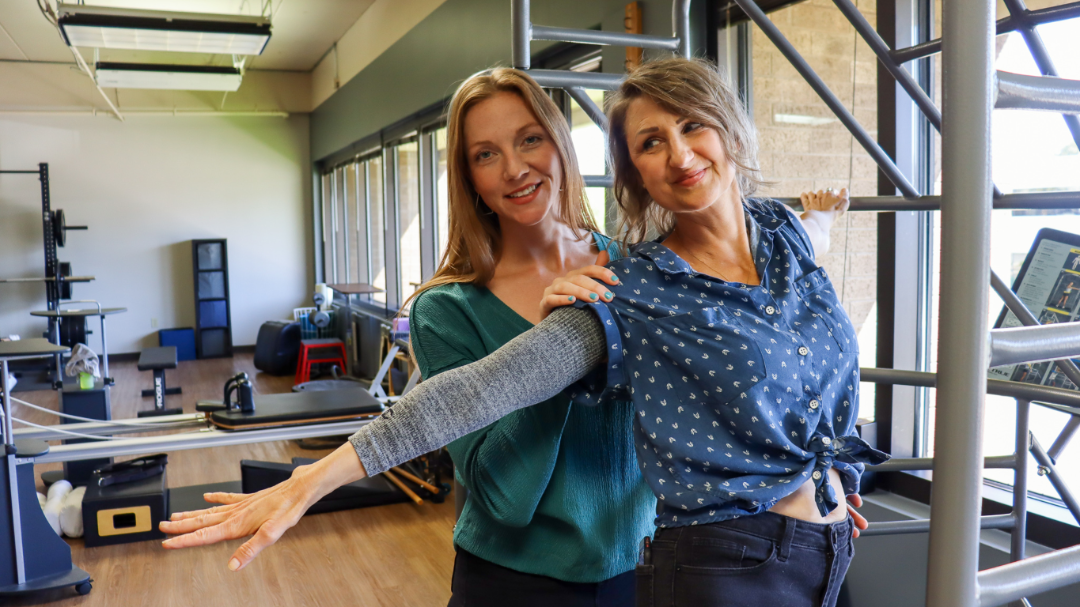April is Occupational Therapy month and we want to highlight the occupational therapy profession and how occupational therapists empower everyday living. The Spooner occupational therapist’s holistic approach to patient care is critical to their success, and we love to see the many ways our team helps patients achieve their goals.
What is Occupational Therapy?
According to the American Occupational Therapy Association, “Occupational therapists and occupational therapy assistants are experts in helping people perform the occupations they need and want to do every day” (2022).
What is an occupation? Natalie Black, OT, MOT, stated, “occupations are how we fill our time, what occupies you. It could be anything.” So, think about all of the tasks you do on a day-to-day basis from the time you roll out of bed to the time you lie back down. These occupations can be as mundane as brushing your teeth or as active as going on a run. Within the practice of occupational therapy, there are eight major occupation umbrellas that provide a treatment framework. Ty Pehrson, MOTL/R, CHT, gave us a breakdown of how occupational therapists help patients in those areas of life:
-
1. Activities of daily living
- Occupational therapists help people increase their independence with their activities of daily living by breaking down the activity into individual components, looking at the deficits the patient has in each component such as strength, range of motion or coordination, and targeting those deficits in therapy to return them to their regular daily activities, like eating or dressing.
-
2. Instrumental activities of daily living:
- Instrumental activities of daily living include many of the things one needs to do to manage one’s life, like paying bills, grooming the dog, shopping for groceries etc. Occupational therapists can help patients be independent with these activities by helping the patient create systems that will help them be successful. This could be creating reminder systems, calendars, and also adaptive equipment to allow the patient to perform these tasks independently.
-
3. Rest and sleep
- Many times, a patient’s sleep can be interrupted by pain, discomfort, or preoccupation with their injury. Occupational therapists can help the patient with relaxation techniques or pain-relieving techniques such as elevating the injured limb, breathing techniques, and meditation techniques that will prepare the body and mind for sound sleep.
-
4. Education
- Education has two components for the patient. First, occupational therapists educate the patient on their injury or disorder so they can be informed about their own body. Second, they can give the patient options for augmentative devices or techniques to complete their education such as a communication board or other electronic communication systems, adaptive writing or typing utensils, and voice-to-text software.
-
5. Work
- Occupational therapists help patients return to work through getting an in-depth occupational profile of the patient. Then, OT’s can create a treatment plan that targets specific job tasks and conditions the patient in those tasks to return to work safely and quickly.
-
6. Play
- Many times, after injury or disease, the patient loses interest or feels incapable of participating in their normal play activities. Occupational therapists assist the patient in exploring options of play that are meaningful to the patient, safe, and provide community resources for the patient to participate in new play activities. For example, a patient who may have experienced a spinal cord injury and is now using a wheelchair for mobility may be interested in a wheelchair basketball league.
-
7. Leisure
- Leisure activities are part of a healthy and balanced life. Many times, patients who have experienced life-changing injury or illness lose interest in leisure activities. The occupational therapist can aid the patient in remembering leisure activities that have meaning to the patient and also explore new options for leisure activities that can help the patient find joy relaxation that is very needed.
-
8. Social Participation
- Occupational therapists play an integral role in returning a patient to their regular social participation. Many times, the patient is in need of support for their injury or illness and an occupational therapist can give the patient recourses for support groups and counseling if needed. They can also help the patient return to normal social activities with adaptive equipment that is needed.
Treating the Whole Person
Also think of something you look forward to doing every single day. For some, it is picking up their child. For others, it’s their gym session. It doesn’t have to be one thing, either. Any action or event that brings you joy is what Natalie calls a “cherished occupation.” While an injury may functionally impact one’s work, it could emotionally impact another aspect under the occupational umbrella deeper.
Occupational therapists address the whole person. They look at how the injury or dysfunction impacts not only their movement, but how it affects the patient’s mental health. They utilize this whole person approach in all they do, in order to, get you back to your cherished activities.
We are so thankful for our hand therapists, of whom many are occupational therapists. Spooner hand therapists have extensive training in treating the upper extremity, from fingertip to shoulder, in relation to those cherished activities you want to accomplish.
Don’t put off your cherished activities any longer. Schedule an appointment with a Spooner hand therapist today to start moving and feeling better.
References
- American Occupational Therapy Association. (2022). Become an OT/OTA: About Occupational Therapy. About the Profession. Retrieved March 21, 2022, from https://www.aota.org/career/become-an-ot-ota/about-the-profession
- Black, Natalie, Paul Gagliano, and Dan Miriovsky (Hosts). (2021, August 25). You down with O/PT?
Yeah you know me! (Ep. 68) [Audio podcast episode]. In Therapists In Motion. https://www.spoonerpt.com/spooner-blog/ep-68-o-pt-yeah-know/

